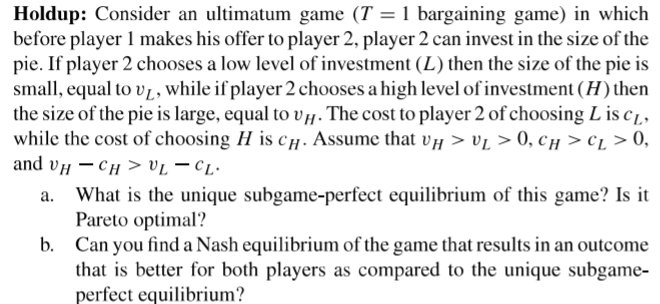Holdup: Consider an ultimatum game (T = 1 bargaining game) in which before player 1 makes his offer to player 2, player 2 can invest in the size of the pie. If player 2 chooses a low level of investment (L) then the size of the pie is small, equal to vL, while if player 2 chooses a high level of investment (H) then the size of the pie is large, equal to VH. The cost to player 2 of choosing L is c1, while the cost of choosing H is CH. Assume that ví > V1 > 0, cH > CL > 0, and vH - CH > vL = CL· What is the unique subgame-perfect equilibrium of this game? Is it Pareto optimal? b. Can you find a Nash equilibrium of the game that results in an outcome that is better for both players as compared to the unique subgame- perfect equilibrium?
Holdup: Consider an ultimatum game (T = 1 bargaining game) in which before player 1 makes his offer to player 2, player 2 can invest in the size of the pie. If player 2 chooses a low level of investment (L) then the size of the pie is small, equal to vL, while if player 2 chooses a high level of investment (H) then the size of the pie is large, equal to VH. The cost to player 2 of choosing L is c1, while the cost of choosing H is CH. Assume that ví > V1 > 0, cH > CL > 0, and vH - CH > vL = CL· What is the unique subgame-perfect equilibrium of this game? Is it Pareto optimal? b. Can you find a Nash equilibrium of the game that results in an outcome that is better for both players as compared to the unique subgame- perfect equilibrium?
Chapter8: Game Theory
Section: Chapter Questions
Problem 8.8P
Related questions
Question

Transcribed Image Text:Holdup: Consider an ultimatum game (T = 1 bargaining game) in which
before player 1 makes his offer to player 2, player 2 can invest in the size of the
pie. If player 2 chooses a low level of investment (L) then the size of the pie is
small, equal to vL, while if player 2 chooses a high level of investment (H) then
the size of the pie is large, equal to VH. The cost to player 2 of choosing L is c1,
while the cost of choosing H is CH. Assume that ví > V1 > 0, cH > CL > 0,
and vH - CH > vL = CL·
What is the unique subgame-perfect equilibrium of this game? Is it
Pareto optimal?
b. Can you find a Nash equilibrium of the game that results in an outcome
that is better for both players as compared to the unique subgame-
perfect equilibrium?
Expert Solution
This question has been solved!
Explore an expertly crafted, step-by-step solution for a thorough understanding of key concepts.
This is a popular solution!
Trending now
This is a popular solution!
Step by step
Solved in 2 steps

Knowledge Booster
Learn more about
Need a deep-dive on the concept behind this application? Look no further. Learn more about this topic, economics and related others by exploring similar questions and additional content below.Recommended textbooks for you

